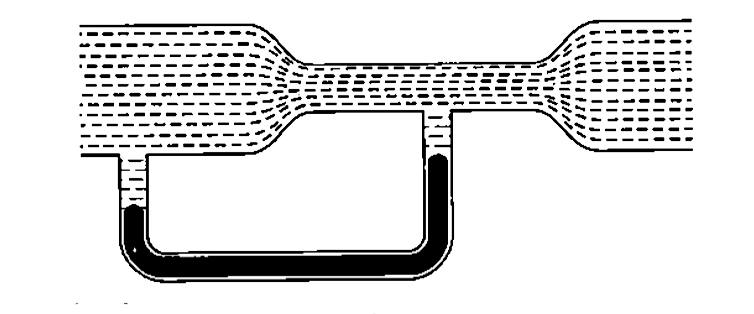The area of cross section of the two arms of a hydraulilc press are 1 cm^2 and 10 cm^2 respectively figure. A force of 5N is applied on the water in the thinner arm. What force should be applied on the water in the thicker arm so that the water may remain in equilibrium?
 ,
,
In equilibrium the pressure at the two sufraces should be equal as they lie in the same horizontal level. If the atmospheric pressure is p and a force F is applied to maintain the equillibrium, the pressure are,
p0+5N1cm2 and p0+F10cm2respectively.
This gives F=50N .
Topper's Solved these Questions
- FLUID MECHANICSBOOK - DC PANDEYCHAPTER - FLUID MECHANICSEXERCISE - Introductory Exercise
1 Videos
- FLUID MECHANICSBOOK - DC PANDEYCHAPTER - FLUID MECHANICSEXERCISE - Exercise16.2
2 Videos
- FLUID MECHANICSBOOK - DC PANDEYCHAPTER - FLUID MECHANICSEXERCISE - Miscellaneous Examples
10 Videos
- EXPERIMENTSBOOK - DC PANDEYCHAPTER - EXPERIMENTSEXERCISE - Subjective
15 Videos
- GENERAL PHYSICSBOOK - DC PANDEYCHAPTER - GENERAL PHYSICSEXERCISE - INTEGER_TYPE
2 Videos
Similar Questions
The area of cross section of the two arms of a hydraulic press is 1cm2 and 20cm2 respectively. A force of 10N is applied on the water in the thinner arm. What force should be applied on the water in the thicker arms so that water may remain in equilibrium?

View SolutionThe area of cross section of two cylinders of a Bramah press are 10cm2and50cm2, respectively. In order to move up a weight of 100 placed on the bigger piston. what force should be applied on the smaller piston of smaller area ?
View Solution
Knowledge Check
The area of cross-section of the two vertical arms of a hydraulic press are 1 cm2 and 10cm2 respectively. A force of 10N applied. As shown in the figure, to a tight fitting light piston in the thinner arm balances a force F applied to the corresponding piston in the thicker arm. Assuming that the levels of water in both the arms are the same, we can conclude:-
 AF=100NBF=50NCF=25NDF, as applied, cannot balance the effect of the force on the first piston
AF=100NBF=50NCF=25NDF, as applied, cannot balance the effect of the force on the first pistonThe radius of one arm of a hydraulic lift is three times the radius of the other arm. What force should be applied on the narrow arm so as to lift 50 kg at the wider arm?
A60 NB54.4 NC26.7 ND30 NThe two arms of a Verical U tube have internal radii of 0.4 cm and 0.8 cm respectively . The tube contains water . What is the difference in the surface levels of water in the two arms ? S.T of water =70×10−3 N/m
A0.7mmB1.785 mmC3.785 mmD5 mm
The cross-section of two piston in hydraulic press are 2cm2and150cm2 respectivley . Calculate the minimum force required to support a weight of 2000kg wt on the broader face of the press.
View SolutionHow much force should be applied on an area of 1cm2 to get a pressure of 12 Pa ?
View Solutionhow much force should be applied on an area of 1 cm2 to get a pressure of 15 Pa?
View SolutionWater flows through the tubes shown in figure. The areas of cross-section of the wide and the narrow portions of the tube are 5cm2 and 2cm2 respectively. The rate of flow of water through the tube is 500cm3/s. Find the difference of mercury levels in the U-tube.

View SolutionA force of 40 N is applied on a nail, whose tip has on area of cross-section of 0.001 cm2. The pressure on the tip is
View Solution
